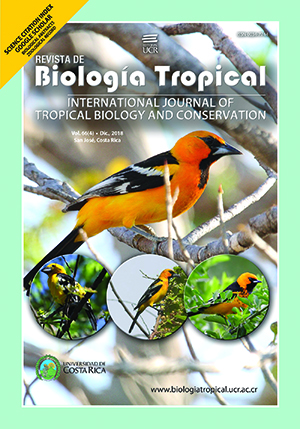Abstract
Arachnofauna studies from agroecosystems are crucial for implements spider as biological control agents. In this work we analyze the distribution of spider assemblages at three microhabitats (canopy, tree trunk and soil) in Citrus sinensis orchards (Rutaceae) in the Province of Corrientes, Argentina. Spiders were collected monthly using four sampling techniques: beating foliage, leaf litter sifting, pitfall traps and direct capture by hand. A total of 2 160 samples were examined and 7 194 spiders were collected (2 462 on the canopy, 983 on trunk and 3 749 on the floor) belonging to 34 families and 200 species/morphospecies of Araneomorphae. There were significant differences among microhabitats and months in the structure of the spider communities, according to analysis of similarity (ANOSIM). The diversity was highest on the canopy, followed by soil and tree trunk. Araneidae, Salticidae and Anyphaenidae were the most abundant taxa in the canopy; the dominant species were Jessica erythostoma and Cheiracanthium inclusum, a predator of the leaf herbivore Phyllocnistis citrella (Lepidoptera) a pest of Citrus spp. The most abundant families on the tree trunk were Tetragnathidae, Hersiliidae and Theridiidae, Iviraiva pachyura was a species specialist in such microhabitat; and Leucauge venusta was an opportunistic species, because their abundance increaseds markedly in anthropic environments that modified by man. The most abundant families on the floor were Lycosidae, Linyphiidae and Coriniidae. In this habitat, Lycosa erythrognatha and Pardosa plumipedata were dominant species. The Chao-Jaccard similarity index was highest between the canopy and trunk (J-C = 0.95), likewise ordination by nonmetric multidimensional scaling (NMDS) revealed strong differentiation between assemblages of soil spiders and canopy and trunk spiders. Also, on the soil the temporary replacement of species was greater and the seriation method was significant (z = 3.82, P = 0.00) therefore there was a succession of species during the year. The different species in each microhabitat probably avoided competition by using different hunting strategies and different ecological resources, in addition to specific patterns of temporal distribution. Our results suggest that anthropic environments, such as in Citrus orchards, tend to harbor populations of spiders able to adapt to those environments and interact in a balanced way in space and time.
Comments

This work is licensed under a Creative Commons Attribution 4.0 International License.
Copyright (c) 2018 Revista de Biología Tropical






